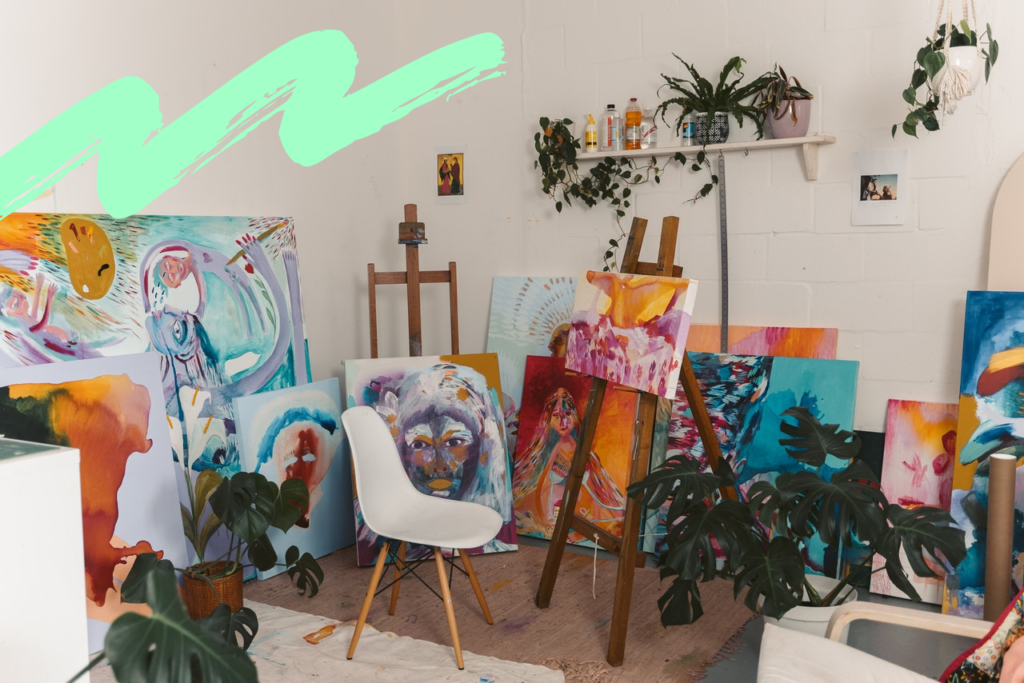When it comes to choosing and hanging art at home, the rules of engagement can be more complex than one might think. The right piece can aesthetically elevate a room, create a focal point, or even reveal a bit about your personality. On the flipside, hanging a work of art haphazardly can deflate the impact that the piece could potentially make in the space.
Indeed, displaying art is not just about hammering nails in walls and hanging your favourite pieces in the first spot you lay eyes on. To curate an art-filled space that is harmonious, visually appealing, and reflects your personal style, you need to follow some rules. Whilst we’re well aware that great art is often about breaking them, here are 12 golden rules for displaying and hanging art at home.
Balance A Gallery Wall
When creating a gallery wall or photo canvas grouping, balance is key. Not every piece has to be the same size, but they should visually balance each other out. Start with your largest piece as the focal point, and work outwards, filling in with smaller pieces. Maintain about a 2 to 3 inches gap between each frame for a cohesive look.
Implement The 57 Inches On Centre Rule
The 57 inches on centre rule is an art gallery standard for hanging artwork, employed worldwide. In simple terms, this rule suggests that the centre of any artwork should be 57 inches off the ground. The reasoning behind it is straightforward—it places your artwork at human eye level (average human eye height is 57 inches), providing an optimal viewing angle for most people.
It should be noted that this doesn’t account for significantly high or low ceilings and the scale of the furniture around it, so it’s always important to consider the specifics of your space.

Mix Artists & Eras
Whether it’s a framed Van Gogh reproduction, a collection of Gustav Klimt prints, or even an original work by your favourite local artist, don’t feel constrained to stick to one period or style. Some of the most engaging wall displays seamlessly blend different artistic movements—perhaps a Rothko-inspired abstract print alongside a classical Turner landscape, or a bold Kandinsky reproduction next to contemporary photography.
Even mixing mediums, such as pairing a Monet with traditional Japanese woodblock works by Hokusai, can create fascinating visual dialogues within your space. The key is to trust your instincts; if the pieces resonate with you personally and share some connecting element—be it colour palette, subject matter, or emotional tone—they’re likely to work well together.
Use The ⅔ Rule For Grouped Artwork
When it comes to hanging a group of artworks, the ⅔ rule comes in handy to maintain balance and create visual harmony. This rule suggests that the group of pictures or artworks should cover around ⅔ of the wall space available, whether over a piece of furniture or a blank wall. Not only does this maintain visual weight, but it also helps you accurately judge the space required for your art grouping.
Think Vertically
Consider the height of your ceilings when hanging wall art. If you have high ceilings, take advantage of the vertical space by hanging taller pieces or stacking artwork. Remember to maintain that 57 inches centre rule for the bottom piece and build up from there.
On the subject of stacking, here are some crucial pieces of advice for doing just that:
- Spacing: Typically, you should leave 2 to 5 inches between each frame when you are stacking artwork. This depends on the size and style of the pieces; smaller pieces generally need less space, while larger ones need more.
- Sizing: Consider the sizes of the frames when stacking. Mixing different sizes can create an eclectic, casual look, whereas using all the same size for a more formal, organised feel.
- Alignment: Decide on the alignment of the artwork. It can all be centred, or if you’re going for a more modern look, you could have the artwork staggered.
- Balance: Try to balance the visual weight of your artwork. If you have a large piece next to two smaller pieces, the smaller pieces can be stacked to balance out the larger one.
- Theme: For a cohesive look, the artwork should have a unifying element. This could be a common colour scheme, subject matter, or style of frame.
- Anchor Point: Start by hanging the centrepiece at that magic 57 inches eye level we keep mentioning.
- Grounding: If you’re stacking artwork from the floor to the ceiling, don’t leave a large gap at the bottom. The first piece should be just a few inches above the baseboard to ground the arrangement.
- Safety: Make sure all stacked artwork is securely anchored. If one falls, others could also fall and break. More on safely hanging your artwork a little later, by the way…
Ensure Artwork Proportions Complement Furniture Proportions
The size and scale of your artwork should complement the furniture around it. A good rule of thumb is to fill ⅔-¾ of the wall space above your furniture with artwork. So, if your sofa is 84 inches long, the artwork or group of artworks should be approximately 56 to 63 inches wide, thus maintaining a pleasing proportion.

The Rule Of Three
Whether you’re arranging a trio of artworks, a set of three prints or partitioning your wall into thirds for a single piece, the rule of three can enhance the overall look. Grouping objects in odd numbers is more visually enticing, and trios feel more natural and less contrived than even-numbered arrangements.
The Power of Pairings
All that said, pairs can sometimes provide the balance a room needs. When hanging a pair, treat them as a single unit during the measuring process. Symmetry works well with pairs – keep 2-5 inches between the pair and centre them as a unit within their given space.
Lighting Is Key
Even the most stunning artwork can lose its charm if not properly illuminated. Spotlighting or using picture lights can accentuate your artwork and make colours pop. If possible, hang your art where it can get plenty of natural light, but avoid direct sunlight as it can fade the artwork over time.
Consider Sightlines
Lastly, consider sightlines. How does the piece look from different vantage points? You want the art to enhance the space, not just look good from one spot. So, consider the views from doorways, windows, and other rooms, ensuring your artwork is visually appealing from various angles.
Rotate Your Art Seasonally
Lastly, just as you might change your home decor with the seasons, consider rotating your artwork to keep your space feeling fresh and dynamic. This not only gives different pieces a chance to shine but also allows you to appreciate your collection in new ways throughout the year. You might choose to display brighter, more vibrant pieces in the spring and summer, and switch to more subdued, cosy artwork in the autumn and winter. This practice can also help preserve your artwork by reducing prolonged exposure to light and environmental factors.

Maintain Safety Measures
We said lastly, but safety first (and last) and all that, so…
While aesthetics is the priority, safety comes in a close second when hanging art. Here are some appropriate steps to ensure your artwork hangs safely:
- Choose the right spot: Before you start, determine where you’d like to hang your artwork, ideally using the golden rules we’ve already presented to you in this article!
- Use the right hardware: Depending on the weight of the artwork, you might need different hanging hardware. For heavier pieces, you should use wall anchors or picture hangers that are rated for the weight.
- Find a stud: If possible, try to hang your artwork on a stud in the wall. This is the safest and most secure place to hang something heavy. You can use a stud finder to locate the studs.
- Mark your spot: Once you’ve decided where the artwork will go, make a light pencil mark on the wall where the centre top of the artwork will be.
- Measure and calculate: Determine the distance from the top of your artwork to its hanging mechanism (a wire, hook, etc.). Measure down that distance from your pencil mark and mark that spot. That’s where you will install your hanger.
- Use a level: For optimum safety and aesthetics, ensure your artwork is level after you hang it. You may need to adjust slightly after hanging if it’s not completely level.
- Avoid direct sunlight and humidity: To maintain the integrity of your artwork, avoid hanging it in places with lots of direct sunlight, high humidity, or extreme temperature changes
- Secure the artwork: For larger pieces or in areas of high traffic, consider using wall protectors or bumper pads placed on the back of the artwork to help keep the piece in place.
- Consider professional help: If you’re not confident in your ability to hang the artwork, consider hiring a professional. This is especially true for valuable or significantly heavy pieces.
The Bottom Line
Remember that these rules are not set in stone — they should serve as guidelines, which are sometimes, of course, meant to be broken and rearranged. Remember that your home is your personal space, and your art should reflect your own unique aesthetics and creative vision. Happy hanging! Hmmm, that sounds a bit odd, actually.





